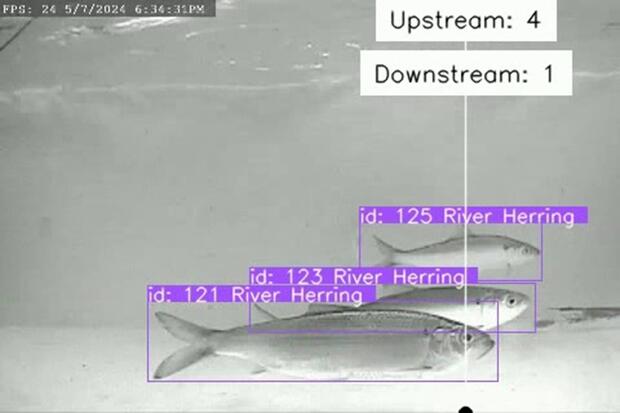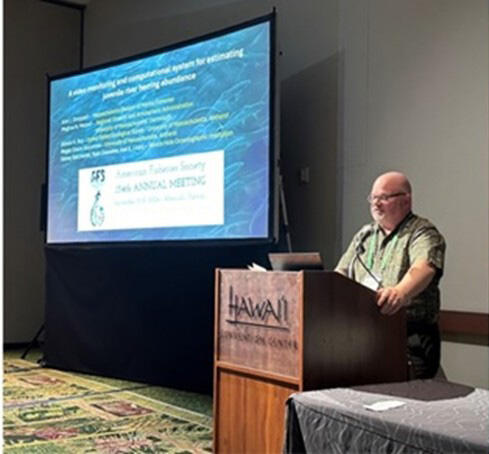- Division of Marine Fisheries
Monitoring alewife and blueback herring abundance during their annual spring spawning migrations from ocean waters to freshwater habitats is a vital component to the management of these species (collectively referred to as “river herring”). Currently, between 40 to 50 streams are monitored for river herring passage in coastal Massachusetts each year. Three rivers, the Monument River (Bourne), Back River (Weymouth), and the Mattapoisett River (Rochester) have been monitored dating back as far as 1980 and are among the longest time series of abundance estimates for river herring on the east coast. DMF and project partners have traditionally monitored these populations using visual counting programs or electronic resistivity fish counters. However, both of these monitoring techniques present challenges which has been leading diadromous fisheries biologists to test and adopt alternative approaches.
Visual counting is the most widely used method to estimate herring run size due to minimal costs in monitoring equipment. However, it presents several limitations including the reliance on large numbers of volunteers that must follow a randomized counting schedule which can be challenging to maintain over time. Also, while a statistical design is utilized, the population estimates derived from visual counts are less accurate than those derived from electronic and video systems largely due to a lack of continuous monitoring. For these reasons, only a few rivers monitored with visual counts have been accepted for use in coastwide stock assessments (e.g., Back River, Weymouth; Nemasket River, Middleborough; and the Mystic River, Medford).
Electronic resistivity counters have also been used by DMF to monitor passage and estimate river herring spawning run size since the mid-1980s. These systems provide more accurate abundance estimates (greater than 90% accuracy) mainly due to their ability to monitor continuously. However, their downsides include requiring daily maintenance to ensure the counting tunnels are free of obstructions and are set at sufficient depth and velocity so fish can pass through safely and efficiently, and an inability to differentiate between species or provide information on diel movement patterns (time of day when fish are passing). Furthermore, the one company that designs these systems is no longer manufacturing new units, hence DMF along with other state and non-government agencies that utilize these systems will need to seek alternative technologies to maintain high-quality abundance estimates at these long-term monitoring stations.
Video monitoring is growing in popularity and use among state, federal and non-government agencies to count migratory fish. As with electronic resistivity counters, video systems can monitor continuously when properly maintained. They have the advantage over electronic counters in that they can monitor multiple species as well as record when they are passing. In addition, video systems are popular tools for outreach and education in that the public can view and count fish either onsite via a live feed to a viewing monitor, or in many cases, online via the internet.
DMF began to explore the use of video monitoring in the mid-2000s in a cooperative research study with the University of Massachusetts, Amherst. In this study, above water cameras were deployed in four locations to record the spring spawning run (Back River, Weymouth; Charles River, Watertown; Monument River, Bourne; and Town Brook, Plymouth). From this footage, video clips were randomly selected for passage counts and run size estimation using DMF protocols. The results identified several limitations which included water clarity, lighting and power requirements, as well as a high degree of variance in the estimates. This study was a first step to explore the application of video for monitoring and counting and the results led to strategies to improve protocols and the accuracy of abundance estimates.
The evolution of video monitoring in Massachusetts continued in 2013 with DMF’s deployment of underwater cameras for field trials, first at three sites (Mill River, Taunton; Nemasket River, Middleborough; and Herring River, Harwich), and subsequently, at other locations in Newbury (Parker River), Orleans (Pilgrim Lake), and Aquinnah (Herring Creek). These sites were either monitored directly by DMF or in cooperation with local groups. In addition, video systems have been deployed by municipalities and watershed associations at several other locations. With the continuous monitoring provided by these systems, efforts were made to shift from run size extrapolation of full estimates to total run size counts. To do this requires reviewing hundreds of hours of video footage and manually counting all the fish in the videos, which has proven to be an incredibly time-consuming effort and a major limitation to current video monitoring efforts.
Enter artificial intelligence (AI) and machine-learning programs. These technologies have been expanded for use in a wide variety of applications, and in recent years, research has been conducted with regards to identifying and counting fish. In 2015, DMF, in collaboration with the Woods Hole Oceanographic Institution (WHOI) SeaGrant Program and UMass–Amherst, dipped their toes into these waters when they were awarded a grant to design a novel video monitoring system that could record and automatically identify and count juvenile river herring as they are emigrating from freshwater to the marine environment. The system was designed by WHOI scientists along with researchers from the University of Florida and was deployed in the Monument River, Bourne, for four juvenile emigration seasons (June through November) between 2017 and 2020. To process and analyze the footage, a machine-learning algorithm was developed by training several neural network models to detect and count fish in video frames randomly selected during the 2017 emigration season. To verify the accuracy of each model, the fish in each frame were counted manually by humans and the estimates compared to counts derived from each neural network model. The top performing model had an error rate of just 9.4%. This is one of the first studies applying AI to develop an automated fish counting system. The system not only has the capability to produce estimates of daily passage as well as estimates of juvenile abundance but can also be used to decipher environmental factors influencing the timing and behavior of juvenile emigration. Information on this study (Marjadi et al., 2024) is available on the DMF website: Contributions List.
This past September, DMF, in partnership with the Massachusetts Institute of Technology (MIT) SeaGrant Program and the UMass–Dartmouth, organized and hosted a symposium on advanced technologies for fisheries monitoring at the American Fisheries Society annual meeting. The above study, along with similar research being conducted, was presented in this symposium, which provided a forum for networking and future collaborations. As a result, DMF is currently working with academic institutions (MIT, Northeastern University Institute of Experimental Robotics, and the Woodwell Climate Research Center) to research and develop deep-learning algorithms to count and estimate adult river herring spawning runs in Massachusetts, including the Coonamessett and Santuit rivers. With the price of equipment decreasing and with further improvements to neural network programs, the potential for applying AI to fisheries monitoring shows great promise in developing high accuracy abundance estimates while greatly reducing the time invested in reviewing video and manually counting fish. In a rapidly changing world of technology, DMF is endeavoring to stay on the cutting edge to maintain high quality monitoring, data collection, and reporting.
By John Sheppard, Diadromous Fisheries Biologist


